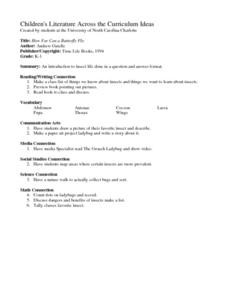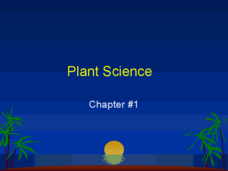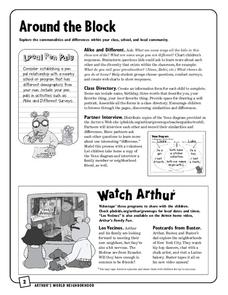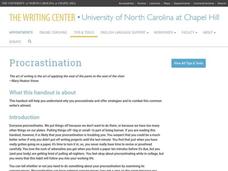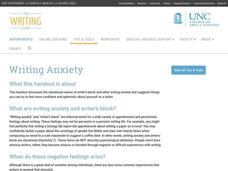Curated OER
How Far Can a Butterfly Fly
Pupils draw a picture of their favorite insect and describe. Students make a paper art project ladybug and write a story about it. Pupils map areas where certain insects are more prevalent. Students count dots on ladybugs and record.
Curated OER
Fish Identification Skills
Pupils describe the roles of various organisms in the same environment. They study fish based on thier behavior and features. In addition, they identify fish based on specific characteristics.
Curated OER
Henry VIII
Designed for young learners, this lesson plan helps them recognize features of famous people - most notably, Kings and Queens. After a class discussion about Kings and Queens, groups of learners create images of Henry VIII. Their...
Curated OER
The Dirt on Plants
Students draw and label the four parts of a plant. They describe changes that are part of the common life cycle. Students follow various one and two step directions. They are asked to discuss that they can recall about plants.
Curated OER
Sampling the American Dream
Students, after viewing a variety of different and unique websites, write a short paragraph on each one that describes their reactions to specific information on unfamiliar subjects. They react to each website as personally as they can.
Curated OER
Plant Science Chapter #1
It may not stand as a cohesive presentation, but individually you may find a use for these slides. One slide describes how civilization began once man learned to plant and harvest food. Another explores the population growth over time....
Curated OER
Past Conditional
This printout could be used to introduce the past conditional to your middle schoolers. The top section describes the past conditional and notes examples. There's a short post-assessment included, as well.
Curated OER
Odd Thing Out
Students listen to the math problem provided and work in groups to solve. They think about the objects and write down their information in a table. Class construct the table on a large piece of paper that can be put on the wall after the...
Curated OER
Looking at the Community Tree
Third graders review the characteristics of living and nonliving organisms. As a class, they observe a tree and describe the interactions between the living and nonliving organisms surrounding it. To end the activity, they ask a...
Michigan State University
May I Take Your Order?
If you're a pest, come and get a tasty meal here! Scholars work collaboratively to construct a mini restaurant out of a shoe box and create a menu that feeds a pest their favorite food.
Soft Schools
Rewriting Similes and Metaphors
As part of a study of comparison, kids transform similes into metaphors and metaphors into similes.
Baylor College
Needs of Plants
What better way to learn about plant life than by creating a class garden? Young botanists start with a brief discussion about radishes before planting seeds and watching them grow. To determine the importance of water,...
Cornell University
Bridge Building
Bridge the gaps in your knowledge of bridges. Individuals learn about bridge types by building models. The activity introduces beam bridges, arch bridges, truss bridges, and suspension bridges.
PBS
Around the Block
Arthur and his friends help children explore the concepts of family, community, and diversity in a fun series of activities. From performing peer interviews to mapping out the different places students have lived or visited, this...
Spreading Gratitude Rocks
A Note of Gratitude
Gertrude Stein once said, "Silent gratitude isn't much use to anyone." Learners break their silence by engaging in discussion and making lists of what makes them grateful. Next, pupils write and illustrate a thank you letter to a chosen...
University of North Carolina
Procrastination
Inevitably, whenever you give an assignment, at least one person won't start until the last minute. As the 13th handout in the 24-part Writing the Paper series explains, procrastination sometimes brings consequences. It breaks down...
Huntington Library
Everyday Life - Exploring the California Missions
Young scholars relive history as they examine primary sources that document everyday life in the California missions. During a class viewing of the included slideshow presentation, children analyze documents, paintings, and...
Kenan Fellows
Evaluating Sensors and the Impacts of Physiological Stress: Designing a Wearable Device for Rescue Workers
A long-term project has scholars consider ways in which sensors help monitor physiological stress levels of rescue workers. They design and create a portable device for this purpose. Techies to the rescue!
Center for Civic Education
What Is Authority?
Young scholars examine the concepts of power and authority as they begin learning about government in this elementary social studies lesson. Through a series of readings, discussions, and problem solving activities, children...
Computer Science Unplugged
Beat the Clock—Sorting Networks
Can multiple computers sort a list faster than one? Using a network drawn with chalk outside, groups move through the decision network to sort numbers. A series of extension questions come with the lesson and can be used in the same...
PBS
Hidden Alarm
It's time! The fourth lesson in a five-part series has teams of scholars build a circuit for an alarm. A switch lets them turn the alarm on and off and allows them to hide the alarm—just as long as they don't hide it in the classroom!
University of North Carolina
Writing Anxiety
Oh, the dreaded writer's block! As part of a larger paper-writing series, an invaluable resource discusses obstacles and stresses writers face. Individuals learn to identify feelings associated with anxiety, as well as strategies for...
Curated OER
Prepositions
Prepositions are an important part of descriptive writing. Fourth graders fill in the blanks with prepositions from a word bank, then write ten sentences with the remaining words.
